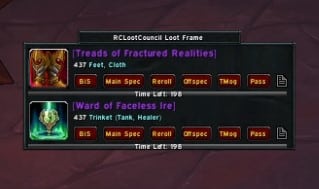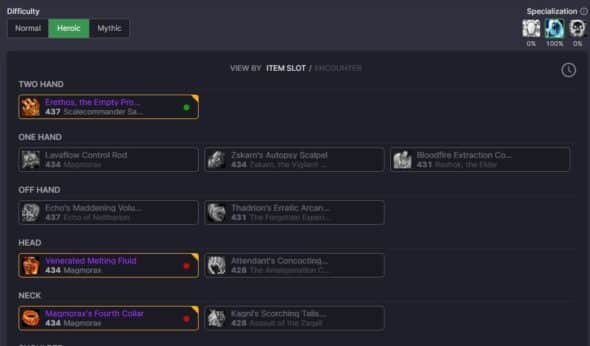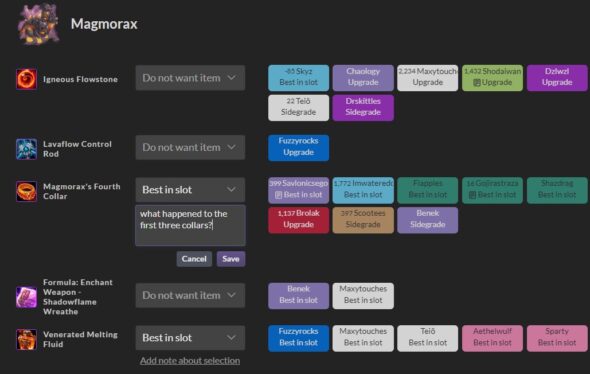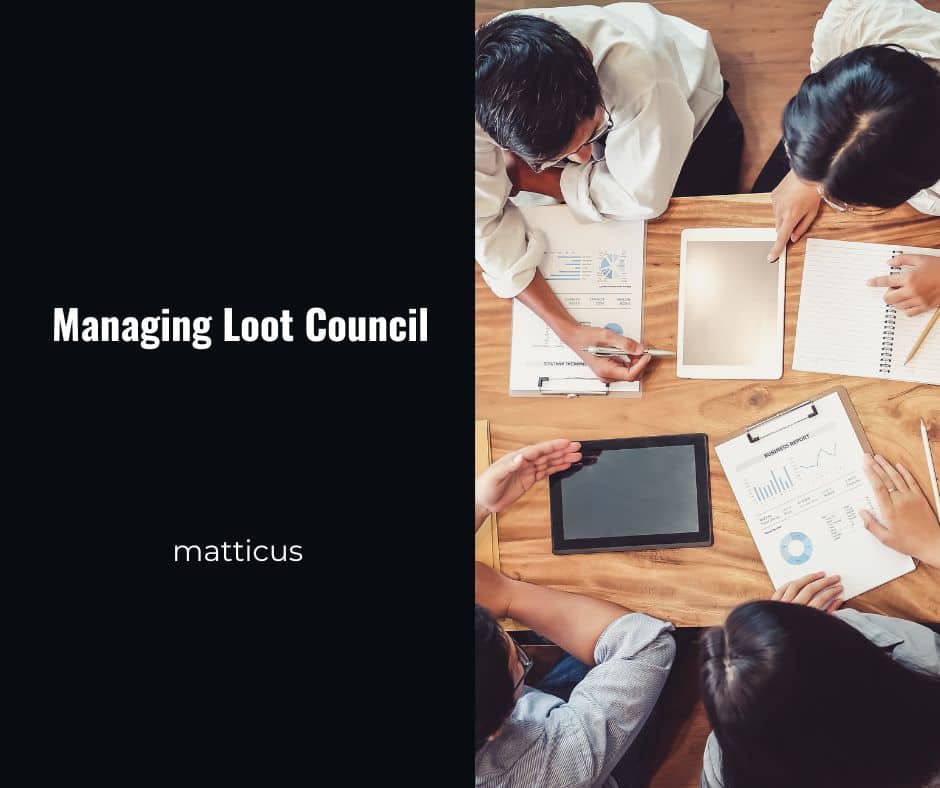One of the more controversial loot systems for guilds is Loot Council. There’s nothing wrong with the system. Any issues with Loot Council has always revolved around people. As long as players and loot council understand that decisions are made in the best decision for the raid, everyone can sleep easily. Loot council doesn’t determine who gets what loot, it determines who gets what loot when. The last time I wrote about loot factors was about 14 years ago and I thought it deserved a refresh into today’s climate since we have all these new systems in place.
Depending on how geared your raid is, you can always opt to skip Loot Council for certain items. Some items that dropped from normal started out at 415 but many of our raiders were already wearing 421s or had higher equipped from Mythic dungeons earlier in the week. It may not be worth Loot Council’s time to manually sort those ones out for smaller sized items that offer little to no power gains.
Resources
- RC Loot Council (Addon): RC Loot Council is currently the addon of choice here due to Blizzard’s policy of eliminating master loot. This addon will cause every player to pass on loot and the loot master can initiate a loot window popup.
- Readycheck.io (Site: For your loot wishlists and spreadsheet)
- wowaudit.com (Site: Alternative)
Voting options

Selection options can be quite contentious. Each guild I’ve been in has always had some variation on what the options were. In DJs, we have the following and here’s how I’d describe it:
- BIS: Your best in slot item, period.
- Main spec: This is an upgrade but it’s expected it will be replaced later.
- Reroll: Player has the item already but wants to gamble for a socket or tertiary stats.
- Offspec: Would be used for a different spec or role.
- Tmog: Entirely for looks.
- Pass: No interest in it whatsoever.
This encompasses most of our needs. There’s a little note icon on the far right. Most players don’t know about this, but you can leave a note about the item when you submit your selections. Maybe this completes a set bonus for you, as an example. Another case is that the trinket you’d like isn’t something you would use regularly but only in select situations like for Mythic+ or heavy encounters with lots of additional monsters.
Selecting Council Members
In my previous guild, I tried to rotate people in loot council after every tier just to give everyone a crack at it. The number of people can range anywhere from 2 to 5. I don’t recommend going higher than that. Pick players who are knowledgeable at raiding and gearing, while being able to help prioritize what’s most beneficial for the raid (and yes, it’s possible to have two correct answers). Don’t put too many healers in there (you might need a few healers to help clear trash and it can be cumbersome to vote while healing).
Let’s look at some of the factors that can influence loot decisions.
Player Roles
DPS checks are a constant in any encounter. With enough firepower, you can skip phases before they become dangerous to the team. Most guilds that raid at the top level will award gear to DPS players first. The sooner the boss is defeated, the better. This changes when the raid encounters a specific healing check and they have to plan for that accordingly. Even then, this can be offset with another healer. Not only that, mythic plus is an available avenue for healers to acquire gear from. My Priest gets whatever unwanted gear from raid but I resort to camping out in mythic dungeons fishing for upgrades. Does it suck? Yeah, but that’s how it goes. I’ll get my raid upgrades later on in farm when DPS players aren’t in need of it.
Player lineups
Think ahead to upcoming encounters and which players are most likely to see progression time and which ones aren’t. Are you really going to give a 2H weapon to a Warrior who you’re not going to start on Rashok progression in Mythic? Gear is only relevant if it’s going to be used. If a raider is going to be away for two weeks or they’re not going to be in on a hard boss coming up or for Mythic progression, then it doesn’t make sense for them to get upgrades right away. Send upgrades to the players who are in the starting lineup.
Power gains
How big of an upgrade is the item in question? Is it from an LFR piece to a Heroic piece? These things have relevance too. Try to identify big power gains for players who haven’t been as lucky from dungeon or raid drops. Heading into Aberrus, we relied on 4-piece tier sims to get a better idea of relative power gains from set bonuses. Generally, this is what most intermediate loot councils will look for as it’s often the easiest indicator to eyeball. Don’t get fooled though as there are some items which are simply too good to replace. The Mythic version of Seal of Diurna’s Chosen continues to be quite good for some despite other ring options available coming from Aberrus.
Gear ranking and utility
I tend to use different gear based on what I’m doing. I have different gear for raid and dungeon content with different stats. There are items that will drop from raid which I wouldn’t normally use in a larger raid setting but that I would absolutely equip in a dungeon setting when pushing keys. I’d classify this as an offspec or a sidegrade type. There are some fun utility trinkets that may not be the best for player throughput but offer some neat functionality like Storm-Eater’s Boon or Ward of Faceless Ire.
Trinkets and weapons
Big-ticket items like these represent huge power spikes. These ought to go to your heavy hitters here. In Aberrus, there are early raid and late raid items which correspond to different item levels. Most raiders will opt for the really good ones later on in the instance as they’re often higher item level than any of the stuff that drops early on. Still, don’t skimp on these. Even if they’re smaller upgrades, every stat helps. Raiders should at least mention that they’re upgrades even if it isn’t a best in slot item because the stats on these could represent the difference between a 0.5% wipe and a kill. Absolutely express interest in these even if it isn’t your best items. Upgrades are upgrades.
Player seniority
Your raid is going to have its regulars and veterans, but most progression guilds will have a few trials. I would feel extremely uneasy if your big ticket items (late raid weapons, trinkets, tier, or other very rare items) went to a trial player in the raid over a veteran. Trial players are often an unknown quantity and have the potential to be a flight risk. Sometimes things don’t work out in the raid and both decide to part company, and any gear invested in them is lost. That being said, use some discretion and judgment. If it looks like a trial player is acclimating quite nicely with the community, participating often, and being a productive raider, they deserve something (and if this is the case, why are they still a trial?). Be sure to balance that with the veterans who’ve been on your roster for a long time and have been helping the team get to where they are now. Don’t neglect them.
Set bonuses
Finishing 2 piece and 4 piece bonuses are huge power spikes for the raid for most classes and specs. Some classes have it better than other classes, so be sure to review and identify which ones are bigger gains. I know for a few specs, the 4 piece isn’t actually that great. Try to finish as many bonuses here for players. You’re sort of at the mercy of the raid gods here. Our first week in, we barely got any of the Venerated tokens (Priest token) on either of the two raid difficulties.
Crafting replacements
We’re at the mercy of the new Sparks here that drop every couple of weeks. Most progression-oriented raiders will be aiming to get their weapons crafted at the highest level. I got my shiny staff upgraded this week even though it took me two sparks (I had terrible off hand luck). They’ll be using them for a while until well into mythic raid progression. Future crafted items will go towards embellishments. If the crafted embellishments are better than raid drops, then they might pass on loot that drops in raid. Tag these as minor upgrades at least because they can still contribute to stat upgrades until you get the crafted stuff made with the desired embellishments.
Error Decisions
Mistakes happen. Trust that your loot council will try to make decisions that benefit the raid. It’s possible that the information they have on hand isn’t accurate or something wasn’t properly updated. Or maybe they just screwed up. Information involves raiders being honest and mindful when they select their loot options. Your loot council is human and they will make mistakes especially when starting out for the first time. It’s a big switch going from DKP or personal loot or need rolling to a loot council system and not everyone is always going to agree.
Story: We had a Mythic Whispering Incarnate Icon drop and the decision was between two players: A Shadow Priest and a Hunter. Based on assorted factors, we assigned it to the Shadow Priest only to realize he was already wearing a Heroic Icon and our Hunter had not received one at any level yet! Oops! Once we were made aware of this, our council team reached out and expressed that we goofed without properly checking. It was too late to make the correction, but the team said they would find a way to correct that in the future. The lesson here is to inspect and confirm what eligible players are wearing before awarding that gear.
Scenario
Here is a situation that can come up. Imagine there are two Hunters in the guild. You have Haydn on one side, and Pachelbel on the other.
Haydn has been a veteran raider with the raid over four expansions while serving in a leadership capacity. He makes a few odd gameplay mistakes here and there but has been a staple presence in the team offering insight and raid strategy while assisting players with whatever they need like extra gold for repairs, consumables for the forgetful, and stepping in for keys if the group is missing a player. In raid, his damage variance can swing from a top 5 performer to just the average player in the middle of everyone else.
Pachelbel on the other hand just passed his trial. His decision making is sound, and his damage output is consistently at the top. He adapts to the situation in front of him and picks up new mechanics and responsibilities eagerly. He rarely takes avoidable deaths and has proven to be reliable when given a job to do. Even though he is new, Pachelbel is making a strong impact and helps the team in a big way with individual contributions.
An extremely powerful cannon drops from the end boss which is the best weapon for both of them. Who would the weapon go to first? You could make strong arguments in favor of either Hunter. Sending the cannon to Haydn is a safe pick even though it may not be maximized to the fullest extent. You know it’ll stay in the raid team and Haydn has more than earned it with everything he does. But you know that if it were Pachelbel’s cannon, it would be wielded with extraordinary effect and fully utilized. Bosses would die that much faster and it would be beneficial with some tough encounters coming up soon in Mythic. Even though Pachelbel has been accepted, what if he decides that the guild isn’t a right fit for him after all and decides to part ways? Any gear gains would have been lost.
There’s no real right answer in this case, and decisions will always be subject to both personal ideology and raid values. Attrition is a constant and any raid can expect loot to be lost over time from players leaving.
Loot sheets
I mentioned sites like Readycheck and WoW Audit as services that you and your raid team can use to determine what items best represent upgrades. Raiders need to go in there individually and can set which items are best for them (categorized by boss encounter). You can even set what the priority of it is such as your best item or major upgrade. Be sure to regularly visit and update it as you go. Don’t want your raid leader to get cranky with outdated information. Do you really need a weapon here once you’ve crafted your best weapon already? Expect raid leaders to build raid compositions based on need. If you don’t need an item from a boss, you might be able to take a seat and relax until you get called up.
In an ideal world, when an item drops, your loot council already knows where it’s going to go and that’s where having loot sheets prepared in advance can help save time.

WoW Audit lets you select which items you’re looking for by item slot or encounter. You can choose how significant of an upgrade a piece is. It even synchronizes with Raidbots.

Readycheck is a similar idea and you have the option to add a note to any of the pieces you’re looking for. It doesn’t seem like there’s an option to sort the dashboard by item slot so you’ll have to go down the list of encounters. This one synchronizes directly with RC Loot Council. Any loot changes can be imported directly.
Other tips
- Never make tanks handle loot. It sucks, but I found more time is wasted if they’re busy handling loot instead of clearing trash. You can get away with healers though since there’s enough of them around that missing one wouldn’t impact trash healing.
- Take your time, but not too much. It’s okay to ask for clarity if you have questions about item usage.
- Test your loot systems before raid. If you’ve never used RC Loot Council before, try it out in test mode. Experiment with the commands ahead of time. Run a small dummy raid with a few people.
- Set a chat channel. For loot, this can be done on in-game, in a dedicated community, or on Discord. Any discussion via in-game chat is going to get lost. Having that chatter on Discord can be better because you can refer back to conversations or even pin various spreadsheets and relevant links.
- Be transparent to an extent. A loot council team does not need to go out of their way to explain every decision and why. They should indicate at minimum who is slated to receive them. It’s up to the team if they want to allow everyone to view the voting frame or not. They can even show which player that council members voted for. This isn’t a good idea because it may invite manipulation or second guessing.
- Problem? Talk to an officer. If you an encounter a questionable loot decision or something you wanted to learn more about, ask an officer about it. Express any concerns or misgivings you have. That’s what they are there to do. It’s okay to not agree with a decision, but once one has been made, that’s that. You should be permitted to express your thoughts because that’s the job of loot council.
Loot Council isn’t for everyone and if you don’t like the idea of the fate of your loot being completely out of your hands, then it’s time to move on and find a new guild that shares your loot philosophy. Thanks for reading! I hope this helps illuminate how a well run loot council can affect your raid and it’s progression. When done properly, it can maximize the raid’s output and durability.
